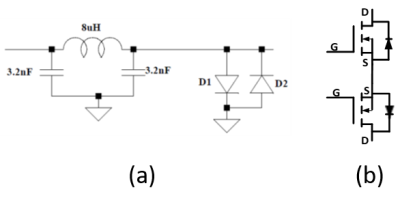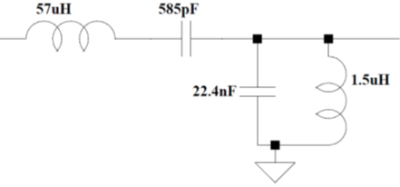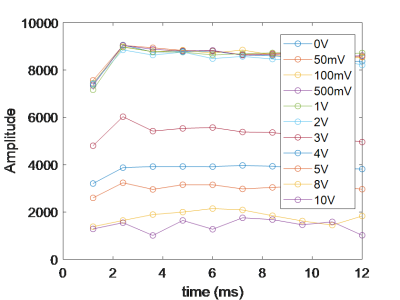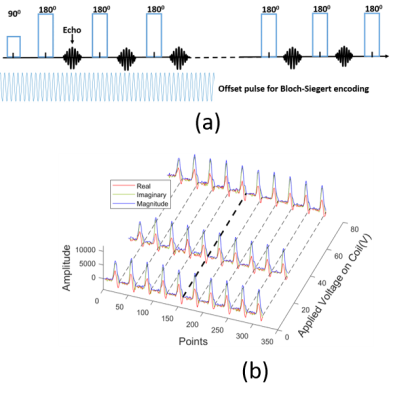3114
Simultaneous transmit/receive for Bloch-Siegert encoding: a feasibility study1Department of Radiology and Biomedical Imaging, Yale School of Medicine, NEW HAVEN, CT, United States, 2Department of Radiology and Biomedical Imaging, Yale School of Medicine, New Haven, CT, United States
Synopsis
This work presents the feasibility of Bloch-Siegert (BS) frequency encoding for magnetic resonance (MR) applications requiring a simultaneous transmit and receive system. RF frequency encoding technique is referred to receiving MR signal while existing one offset-field radiation, which can be considered as a radio frequency interference(RFI). A prototype was built demonstrating first MR experiment and preliminary data using this method. Our system is currently a research technology with the goal of generating a low-field and point-of-care medical imaging system using novel RF encoding.
INTRODUCTION
Recently, our group1-3 has shown the progress of developing BS encoding using an array of coils that would simultaneously irradiate off-resonance at 870 kHz and detect signal on-resonance at 1MHz. Even the array coils3 maintained high isolation with inductive decoupling, strong RFI still was marked when a large RF power was applied in order to obtain enough frequency encoding. MR signal mixed with induced irradiation voltage would feed through the cross-diode of passive duplexer4 into ground before it passes the filter3 in the receive chain. In addition, RF harmonics still bring the issue of pre-amplifier saturation with using a low-pass filter in the transmit chain.METHODS
The RF system was built as shown in Figure 1(a). The schematic diagram in Figure 1(b) includes two coils and a phantom, which implies the challenge in the hardware design: one coil was used to pick up MR signal from phantom while the other was transmitting offset RF pulse. The duplexer and RF filter were furtherly investigated in order to migrate the challenge. The active duplexer5 was used to take the place of the switch in Figure 2(a) to avoid MR signal loss during such experiments. PIN diodes are difficult to drive at low frequency, even if they have very high figure of merit. We therefore focused on semiconductor switches, as shown in Figure 2(b). The key figure of merit for such switch is 1/(Ron*Coff), where Ron is the resistance in the on-state and Coff is the capacitance in the off-state. The value of Ron should be minimum to prevent further noise contribution, while that of Coff should be minimized to keep the isolation between the source and drain in the off-state. In this study, Ron and Coff in our selected (GS66508T) were 0.05Ohm and 65pF, respectively. In the design of drive circuit, DC noise should be carefully considered. We also employed a band-pass filter in Figure 3 replacing the previous low-pass filter2 that removes the issue of receiver saturation enabling simultaneous transmit/receive.RESULTS
First, simultaneous transmit/receive experiment (Figure (1b)) was performed using the passive duplexer shown in Figure 2(a). Signal amplitude decreases as the offset field irradiation improves. This demonstrates that signal losses in critical conduction or ON state of the cross-diode when the induced voltage increases on the receive coil. The similar experiments were performed using the sequence shown in Figure 5(a). For comparison, each acquisition has 10 echoes in Figure 5(b). The front five acquisitions accompany offset irradiation. The peak-to-peak voltage (Vpp) applied on the coil are 0V, 30V and 77V, respectively, which are corresponding to three echo trains. Experimental results demonstrate that the SNR is not affected by increasing RFI. This shows the feasibility of the system in separating the NMR signal in nanovolt level from the strong coupling power in the level of a few hundred millivolts. The filter also successfully removes RF harmonics.DISCUSSION and CONCLUSION
The feasibility of simultaneous transmit/receive was studied at 1MHz. This study demonstrates survival of the NMR signal in strong RFI. The system employed a GaNFET based duplexer with a high figure of merit to avoid signal loss. The band-pass filter in transmit chain helped to better remove harmonics and resulted in a more efficient decoupling. The prospect of this study is that frequency encoding with Bloch-Siegert Shift can be achieved for low field imaging.Acknowledgements
No acknowledgement found.References
[1] Wu B., et al., RF encoding using a simultaneous transmit and receive system. In: ENC.; 2019.
[2] Constable R.T., et al. Design of a novel class of open MRI devices with nonuniform Bo, field cycling, and RF spatial encoding. In: ISMRM.;2019. p. 1546.
[3] Wu B., et al. Strategies to reduce coupling for continuous acquisition of a Bloch-Siegert spatial encoding in low-field MRI device. In: ISMRM.;2020. p. 4044.
[4] Fukushima E. and Roeder S. B. W., Experimental pulse NMR: a nuts and bolts approach. pp.400-407,1981.
[5] Zhen, J. Z., et al. A resistive Q-switch for low-field NMR systems. Journal of Magnetic Resonance, 287:33-40, 2018.
Figures




